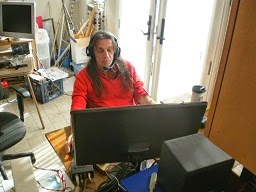I joined up with N6GEO at his home QTH in Brentwood, not with the expectation of winning any operating awards but to test-drive the recently renovated current station setup (FLEX-3000, KPA-500 and his newly acquired 2-el Stepp-IR).
The real goal for this weekend is for us to be ready for the upcoming November Sweepstakes events, where we stand another chance of taking a 1st place as a low power multi-single entry from the East Bay (EB) ARRL section.
Radio contests are all about maximizing operating efficiency; learning to listen, learning to transmit precisely and then making expert use of operating conditions that are sometimes marginal, at best; such as the 7mh yagi in a HOA restricted neighborhood.
 |
| WQ6X & N6GEO |
Overall I like the N1MM+ software; especially the ability to move the individual sub-windows around the PowerSDR screen.
 |
| WQ6X focused on success |
On Saturday at one point, while restarting the FLEX-3000 out of the blue came a message requiring me to UPDATE the firmware or it would shutdown - no option on that one; the update took less than a minute.
Two hours later another (LONGER to install) update was forced onto our operating position. The upside of all this weirdness: afterwards, the PowerSDR software no longer randomly crashed - HuH?
A number of things are noteworthy about this weekend's event, beginning with a solar flux (SFI) of 218 - wOw! Unfortunately, the goeswith was a K-Index of 2 & 3, and in Brentwood a local near-S9 noise source that blanketed 80 & 40 meters.
With the 218 SFI we enjoyed superb band openings on 15 & 10 meters that stayed open until 04:00z both evenings. I would have remained on those bands longer except there were no new stations to work, even though the openings to JA & VK/ZL were still there.
Because of the noise, our numbers on 80/40 were pathetic, altho at least I had the opportunity to get plenty of sleep during the post midnight periods, with an hour of operating time inserted into the 2am (local) time slot on both mornings.
For 2014 CQ WW there were a number of juicy countries and dozens of incredibly unique new prefixes to be worked. While we didn't make DXCC, 70 DXCC countries is not bad for a last-minute put together arrangement, with 55 countries each on 10 & 15 meters. While countries are a nice bonus, for CQ WW it is the Zones that are important, of which we managed only 29; although we heard 38 of them, including Zone 40 - Iceland.
During the operation I made some notes on points foreign operators should be aware of.

Many operators had difficulty getting that there is a "6" in my call. If I used the phonetic Whiskey-Queen-Six, some thought I was in the 3rd call area. In an attempt to help them realize WQ6X is in 6-land, I would remind them that I am in California; which unfortunately did not work. That I reported being in Zone 3 should have been a tip off; but it wasn't. One of the important aspects of radiosport is that we should be improving our operating skills; listening being the most important one.
Once you HEAR what I say, then, use your brain to decipher what message I am seeking to convey.
I noticed that stations running a frequency often did not LISTEN after making a contact, instead just blindly calling another CQ after the pause from having made the previous contact. Had they been listening they would have heard me call them during that pause, making the CQ call unnecessary. Additionally, some stations thinking they worked me would then move on, ignoring the fact that I don't have their information or that they have my call incorrectly. I would keep calling and they would now ignore me. Luckily, the log checking robot (LCR) will give me credit for the contact, but will DING that station for logging ME incorrectly - Oh WELL - their loss.
When a station running a frequency asks for "WQ6", don't fire up on top of me with your W3 callsign, obliterating me - do the ethical thing and wait your turn. And you, the run station, don't then give up on me and work the other station - that simply rewards poor operating on the part of the W3 station. Again, start what you finish - it's the proper operating ethic to do so. To reiterate an above point, a major purpose of radio sport is to improve our operating habits & abilities. To do that well, it makes a huge difference to have an operating plan (preferably written up) BEFORE the competition even begins.
Operating plans will certainly make ALL the difference for the upcoming November Sweepstakes.
Because SS utilizes a REAL 4-part contest exchange (not just a robotic 59 - 03) we are simulating ACTUAL traffic handling. Thanks to this weekend, we have a PLAN for NEXT weekend in the November Sweepstakes, where it REALLY counts.
You can view our CQ WW SSB results HERE and HERE.
Are you going to play Sweepstakes next weekend?
Did you play CQ WW THIS weekend?
If so, is WQ6X in your log?



No comments:
Post a Comment